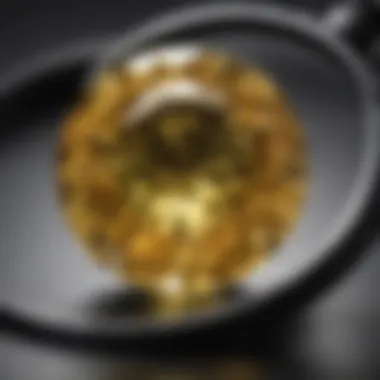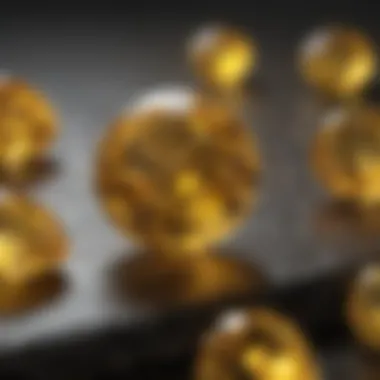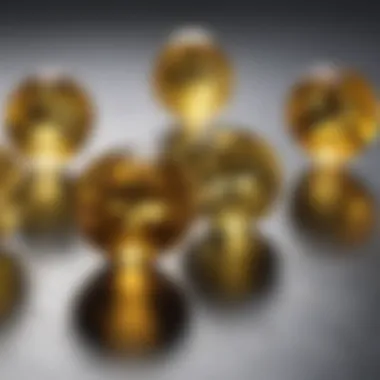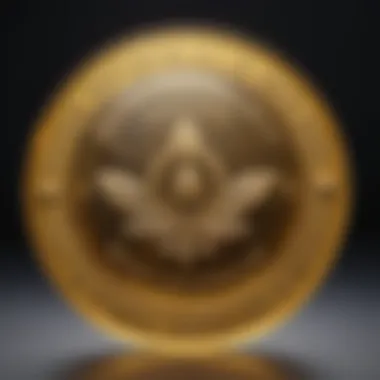Unlocking the Secrets: How to Identify Genuine Yellow Sapphire


Rock and Fossil Identification
Yellow sapphire, a coveted gemstone known for its exquisite beauty and metaphysical properties, holds a special place in the world of jewelry and gem enthusiasts. When it comes to identifying original yellow sapphire, there are key characteristics and factors to consider in order to distinguish it from its counterfeit counterparts. Genuine yellow sapphire is prized for its vibrant color, high clarity, and excellent hardness, which are indicators of its authenticity and quality. It is essential to examine the color intensity, transparency, luster, and inclusions within the stone to determine its genuineness.
In the realm of gemology, tools play a crucial role in examining and evaluating gemstones. A jeweler's loupe, a tool that magnifies the gemstone, can help in scrutinizing inclusions, color zoning, and other identifying features of yellow sapphire. Additionally, specialized gemological instruments such as a refractometer and spectroscope aid in measuring a gemstone's refractive index and spectral properties, providing further insights into its authenticity. When identifying original yellow sapphire, thorough examination and utilisation of these technical tools are indispensable for making an informed assessment.
Collecting Tips and Techniques
For rock and fossil collectors seeking to acquire genuine yellow sapphire, it is imperative to navigate through reputable sources and establish relationships with certified gem dealers or jewellers specializing in high-quality gemstones. By understanding the geological origins of yellow sapphire and its occurrence in nature, collectors can align themselves with ethical suppliers who procure gemstones through ethical mining practices. Furthermore, attending gem shows and exhibitions presents an opportunity to interact with experts in the field, increasing one's knowledge and discernment when collecting yellow sapphire.
Locating prime collecting sites for yellow sapphire involves research and exploration of regions known for producing this gemstone. Areas such as Sri Lanka, Madagascar, and Thailand are renowned for their yellow sapphire deposits, offering collectors a chance to discover genuine stones from reputable sources. When extracting specimens, collectors must exercise caution to avoid damaging the gemstones and adhere to sustainable practices that preserve the natural environment.
Preservation and Display
Upon acquiring original yellow sapphire specimens, collectors need to employ proper preservation techniques to maintain the gemstone's integrity and beauty. Techniques such as storing yellow sapphire in a cool, dry place away from direct sunlight and chemicals help in preventing discoloration and damage over time. Utilizing jeweler's cloth or soft-bristled brushes for cleaning and avoiding exposure to harsh cleaning agents prolong the longevity of the gemstone.
In terms of display, collectors can showcase their yellow sapphire specimens in various creative ways that highlight the gemstone's unique characteristics. Display cases with proper lighting to enhance the gem's brilliance, alongside informational plaques detailing its geological significance and provenance, offer a visually engaging and educational experience for enthusiasts and visitors. Moreover, incorporating yellow sapphire into bespoke jewelry pieces or ornamental settings elevates its aesthetic appeal and contributes to a cohesive display aesthetic.
Geological Insights
Delving into the geological insights of yellow sapphire unveils the fascinating formation processes and historical significance of this gemstone. Originating from sedimentary or metamorphic environments, yellow sapphire owes its radiant hues to trace elements such as iron or titanium present during its crystallization. Through geological studies and cutting-edge exploration techniques, researchers have unearthed valuable insights into the mineralogy and occurrence of yellow sapphire across diverse terrains.
The historical significance of yellow sapphire transcends mere aesthetics, with ancient civilizations attributing mystical and protective properties to this gemstone. Notable discoveries of yellow sapphire in royal treasures and archaeological sites underscore its enduring allure and cultural relevance throughout history. By exploring the geological formations and historical contexts surrounding yellow sapphire, enthusiasts and collectors can deepen their appreciation for this precious gemstone and its enduring legacy.
Introduction
Yellow sapphire, a prized gemstone admired for its beauty and metaphysical properties, is a gem that exudes timeless allure and significance. This article serves as a comprehensive guide on identifying original yellow sapphire from its imitations. By exploring the distinguishing factors and characteristics that set genuine yellow sapphire apart, readers will gain a profound understanding of how to authenticate and value this precious gemstone.
Overview of Yellow Sapphire
Composition and Formation
Exploring the composition and formation of yellow sapphire unveils the intricate makeup of this gemstone. The unique blend of elements and conditions that give rise to yellow sapphire's radiant hues and inherent qualities make it a gem of exceptional allure. The composition signifies the purity and authenticity of the gem, essential in differentiating genuine yellow sapphire from synthetic alternatives.
Historical Significance


The historical significance of yellow sapphire traces back through centuries, where it held mythological and cultural value. Its presence in ancient lore and practices signifies its enduring importance in human history. Understanding the historical context of yellow sapphire adds a layer of appreciation and reverence for this gem, making it more than just a stone but a symbol of tradition and heritage.
Importance of Authenticity
Ensuring the authenticity of yellow sapphire is crucial in safeguarding its value and integrity. Distinguishing between genuine and fake yellow sapphires protects buyers from counterfeit gems and ensures they invest in a true treasure. Authenticity guarantees not just a sparkling gem but a piece of history and significance that transcends its physical beauty.
Physical Characteristics
In the realm of identifying original yellow sapphire, understanding its physical characteristics plays a pivotal role. These attributes serve as the foundation for authentication and appreciation of this precious gemstone. The color, cut, shape, and carat weight are essential elements that define the authenticity and value of yellow sapphire. By delving into the nuances of these physical features, enthusiasts and collectors can discern genuine specimens from synthetic or counterfeit counterparts. Analyzing these characteristics elevates one's appreciation for the intricacies of yellow sapphire and fosters a deeper connection to its allure and rarity.
Color
Natural Shades vs. Synthetic Colors
When it comes to distinguishing natural shades from synthetic colors in yellow sapphire, the aspect of color is paramount. Natural shades exhibit a vivid and vibrant hue that is a result of the gem's geological formation process over time. On the other hand, synthetic colors may lack the depth and authenticity found in natural sapphires, often appearing more uniform and less nuanced. The key characteristic of natural shades lies in their unique play of tones and saturation, showcasing Mother Nature's artistry within each gemstone. This distinction not only adds intrinsic value but also enhances the visual appeal and desirability of yellow sapphire.
Inclusions and Clarity
Exploring the inclusions and clarity of yellow sapphire provides valuable insights into its origin and quality. Inclusions, or internal characteristics within the gemstone, are natural identifiers that confirm the gem's authenticity. These mineral inclusions create a tapestry of patterns and formations unique to each yellow sapphire, acting as a natural fingerprint of its heritage. Clarity, on the other hand, refers to the transparency and purity of the gem, with fewer inclusions equating to higher clarity levels. Understanding the interplay between inclusions and clarity unveils the gem's history and journey from the depths of the earth to its pristine state, enhancing its allure and collectible value.
Optical Properties
The examination of optical properties plays a crucial role in the gemological assessment of yellow sapphire within this guide. Understanding the optical characteristics of a gemstone allows for identification of key features that differentiate natural yellow sapphire from synthetic alternatives. By scrutinizing aspects like refractive index, luster, transparency, asterism, and color change, gem enthusiasts and collectors can delve deeper into the authenticity and allure of yellow sapphires.
Refractive Index
One of the fundamental optical properties to consider when evaluating yellow sapphire is its refractive index. The refractive index indicates how light behaves as it enters and exits the gemstone, affecting its brilliance and sparkle. Genuine yellow sapphires typically exhibit a refractive index ranging between 1.76 and 1.77, a characteristic feature that distinguishes them from other gemstones. Through precise measurement and analysis of the gemstone's refractive index, gemologists can confirm the authenticity of the yellow sapphire and further appreciate its unique optical properties.
Luster and Transparency
Luster and transparency are essential optical properties that lend insight into the quality of a yellow sapphire. The luster of a gemstone refers to its reflective quality, with high-quality yellow sapphires showcasing a brilliant and captivating sheen. Transparency, on the other hand, indicates how light passes through the gemstone, revealing its clarity and internal structures. Genuine yellow sapphires often exhibit a combination of excellent luster and transparency, showcasing the gem's inherent beauty and value. By assessing these optical properties, collectors can discern the authenticity and desirability of yellow sapphires in their collection.
Phenomena: Asterism and Color Change
Asterism and color change are fascinating optical phenomena that contribute to the distinctiveness of yellow sapphires. Asterism refers to the presence of star-like patterns that appear when light interacts with inclusions within the gemstone, creating a mesmerizing visual effect. Rare yellow sapphires may exhibit asterism, enhancing their allure and uniqueness. Additionally, color change phenomenon occurs when a gemstone's hue appears different under varying light sources, adding an intriguing dimension to the gem's visual appeal. Understanding and appreciating these optical phenomena elevate the value and mystique of original yellow sapphires, making them prized possessions for avid gem collectors.
Testing Methods


In this article, the section on Testing Methods plays a pivotal role in helping readers understand how to distinguish genuine yellow sapphire from fake replicas. By delving into the various testing techniques and procedures, individuals can equip themselves with the knowledge necessary to make informed decisions when assessing the authenticity of yellow sapphire gemstones.
Specific Elements: When exploring Testing Methods, attention is directed towards essential aspects such as scrutinizing the gemstone's physical properties, observing its reaction to light and heat, and conducting hardness and density tests. These elements provide valuable insights into the gemstone's composition and quality, aiding in the authentication process.
Benefits: By familiarizing oneself with Testing Methods, buyers can avoid falling victim to counterfeit products and make confident purchases. Understanding these techniques enhances the overall buying experience, ensuring that consumers invest in genuine yellow sapphire gemstones of exceptional value.
Considerations about Testing Methods: It is crucial to acknowledge that while Testing Methods yield valuable information, professional gemological assessments and certifications should ideally accompany any significant yellow sapphire purchase. Furthermore, staying abreast of technological advancements in gemstone testing can further refine one's ability to discern authenticity accurately.
Visual Inspection
Visual Inspection serves as a fundamental aspect of the process when identifying original yellow sapphire. This phase involves a close examination of the gemstone's external characteristics, including its color, clarity, and overall appearance. Through visual inspection, buyers can gather vital clues that contribute to the gemstone's authenticity assessment.
Hardness and Density
The evaluation of a yellow sapphire's hardness and density provides invaluable insights into its quality and authenticity. Determining the gemstone's hardness involves assessing its resistance to scratching, with genuine sapphires exhibiting remarkable durability. Density evaluation, on the other hand, offers information about the gemstone's composition and can indicate whether the stone is a natural yellow sapphire or a synthetic alternative.
Light and Heat Tests
Light and heat tests are crucial components of the authentication process when identifying original yellow sapphire. These tests involve subjecting the gemstone to specific conditions to observe its response, revealing vital information about its unique optical properties. Understanding how a yellow sapphire interacts with light and heat aids in distinguishing genuine stones from imitations, ensuring a reliable assessment of the gemstone's authenticity.
Gemological Reports
Gemological reports play a pivotal role in the process of certifying and grading yellow sapphires. These reports are comprehensive documents that provide a detailed analysis of the gemstone's characteristics, serving as a blueprint of its quality and authenticity.
A gemological report typically includes essential information such as the sapphire's color grade, clarity grade, carat weight, cut quality, and any indications of treatments or enhancements. This in-depth analysis is conducted by experienced gemologists who utilize specialized tools and techniques to assess the yellow sapphire meticulously.
For buyers, gemological reports offer transparency and assurance regarding the yellow sapphire's attributes, helping them make informed decisions based on verified data and expert evaluation. These reports serve as a valuable reference point for comparing different stones and understanding the unique features that make each yellow sapphire distinct.
Gemological reports not only authenticate the identity of the yellow sapphire but also contribute to its market value and desirability. The detailed insights provided in these reports enable buyers to appreciate the rarity and beauty of the gemstone, elevating the overall purchasing experience and ensuring a sound investment in a genuine yellow sapphire.
Market Insights
In the realm of gemstone acquisition, mastering the understanding of market insights is a pivotal element in ensuring a successful and well-informed purchase experience. Within the context of this comprehensive guide on identifying original yellow sapphire, delving into market insights holds a profound significance. By unraveling the intricate landscape of the yellow sapphire market, enthusiasts and collectors arm themselves with knowledge that transcends mere monetary transactions, paving the way for a more discerning and gratifying acquisition journey.
Specific Elements & Considerations
Understanding market insights within the sphere of yellow sapphires encompasses a multitude of critical aspects. From discerning trends in pricing to evaluating demand fluctuations, this segment offers a gateway to comprehending the dynamic forces that shape the gemstone market. By scrutinizing price differentials across various retailers and regions, buyers can identify optimal purchasing opportunities, ensuring both quality and value.


Benefits of Market Insights
The benefits of assimilating market insights extend beyond mere financial gains. By honing the ability to navigate the nuances of yellow sapphire pricing, enthusiasts gain a sense of empowerment and confidence in their buying decisions. Moreover, staying abreast of market trends fosters a deeper connection with the gemstone community, enabling individuals to engage in informed discussions and share valuable knowledge.
Relevance in This Article
In the context of this guide on identifying original yellow sapphire, market insights play a crucial role in empowering readers to distinguish between authentic gems and counterfeit replicas. By shedding light on pricing dynamics and rarity indicators, this section equips collectors with the tools necessary to make educated and fulfilling purchases, fostering a sense of trust and expertise within the gemstone aficionado community.
Trusted Sources
When delving into the world of purchasing yellow sapphires, it is crucial to identify trusted sources to ensure the authenticity and quality of the gemstone. Trusted sources can encompass reputable gemstone dealers, auction houses with a proven track record, and certified gemologists. These sources typically provide detailed information about the origin, quality, and certification of the yellow sapphires they offer, instilling confidence in buyers about the legitimacy of the gemstone.
Established gemstone dealers often have a longstanding reputation for delivering genuine gemstones and adhering to industry standards. Buyers can rely on their expertise to guide them through the process of selecting an original yellow sapphire. Auction houses, renowned for their stringent vetting processes, can also be reliable sources for obtaining authentic yellow sapphires.
Certified gemologists play a vital role in the verification of yellow sapphires, offering professional assessments and certifications that validate the authenticity and characteristics of the gemstone. By consulting with these experts, buyers can gain valuable insights into the quality and value of the yellow sapphire they intend to purchase.
Avoiding Scams
In the realm of gemstone purchasing, navigating potential scams is a critical aspect of ensuring a successful acquisition of original yellow sapphires. To safeguard against fraudulent schemes and counterfeit products, buyers must exercise caution and diligence throughout their purchasing journey.
Common scams in the yellow sapphire market involve misleading descriptions of synthetic stones as natural yellow sapphires, exaggerated claims about the gemstone's rarity or metaphysical properties, and inflated prices for substandard quality stones. Buyers should be wary of deals that seem too good to be true and always verify the credentials of sellers before making a purchase.
One effective strategy to avoid scams is to educate oneself about the characteristics and properties of yellow sapphires, enabling buyers to discern between authentic stones and imitations. Additionally, seeking guidance from reputable sources and consulting with gemological experts can provide valuable insights that help mitigate the risk of falling victim to fraudulent practices.
Seeking Expert Advice
When embarking on the journey to acquire a genuine yellow sapphire, seeking expert advice can significantly enhance the buying experience and ensure a successful purchase. Experienced gemologists, certified appraisers, and knowledgeable dealers can offer invaluable guidance and assistance throughout the process of selecting and verifying yellow sapphires.
Expert advice can help buyers navigate the complexities of gemstone identification, evaluation of quality factors, and understanding of certification standards. Gemological experts possess specialized knowledge that enables them to assess the authenticity and value of yellow sapphires accurately, assisting buyers in making informed decisions.
By consulting with experts in the field, buyers can gain confidence in their purchasing decisions, validate the authenticity of yellow sapphires, and acquire valuable tips on maintenance and care practices. Seeking expert advice not only enhances the buying process but also enriches the buyer's overall understanding of yellow sapphires, cultivating a deeper appreciation for these exquisite gemstones.
Conclusion
Identifying original yellow sapphire is a crucial endeavor in the realm of gemstone authentication and appreciation. Throughout this comprehensive guide, we have delved deep into the intricate world of yellow sapphire, uncovering the key characteristics and factors that set genuine yellow sapphire apart from its synthetic counterparts. Understanding how to discern the authenticity of this precious stone is not only a matter of value but also of appreciation for its unique beauty and metaphysical properties.
The significance of this topic lies in the empowerment it offers to gem enthusiasts and collectors, granting them the knowledge and skill set to make informed decisions when investing in yellow sapphire. By equipping oneself with the ability to identify original yellow sapphire, individuals can navigate the market with confidence, ensuring that they procure authentic pieces that truly reflect the allure and mystique of this gemstone.
Moreover, the benefits of being able to differentiate between real and fake yellow sapphire extend beyond mere material worth. Genuine yellow sapphire carries with it a legacy of tradition and symbolism, making each authenticated piece a connection to centuries of history and cultural significance. By honing their ability to spot genuine yellow sapphire, enthusiasts can deepen their appreciation for the craftsmanship and natural beauty encompassed within each stone.
As one navigates the intricate process of identifying original yellow sapphire, it is essential to consider the nuanced details and unique characteristics that define authenticity. This keen attention to detail not only enhances one's ability to distinguish between genuine and imitation yellow sapphire but also cultivates a deeper appreciation for the craftsmanship and geological processes that contribute to the formation of this captivating gemstone.
In essence, the journey of identifying original yellow sapphire transcends mere gemology; it is a voyage through history, culture, and natural beauty. By immersing oneself in the nuances and intricacies of yellow sapphire authentication, individuals can unlock a world of wonder and fascination, where each stone tells a story of authenticity, craftsmanship, and timeless elegance.







